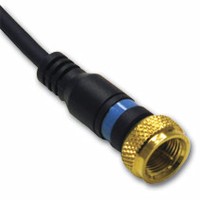 Over-the-air (OTA) broadcast television may be making a comeback with major networks now sending HDTV signals capable of being picked up by the humble rooftop antenna. But subscriber TV services from cable and satellite providers are here to stay. No other option will give the viewer so many programming choices and specialty networks than digital cableTV or satellite TV. These digital services can send near-DVD quality audio and video directly to your living room. But to decode these digital signals you'll need a set top box or STB called a satellite receiver, digital cableTV box or digital terminal. Digital cableTV and satellite receivers behave in much the same way; extracting and processing digital and analogue audio and video from a single coaxial cable run and sending it to your home theater system. In this article we'll examine satellite and analogue/digital cableTV systems to demonstrate how they can be easily integrated into your home theater.
Over-the-air (OTA) broadcast television may be making a comeback with major networks now sending HDTV signals capable of being picked up by the humble rooftop antenna. But subscriber TV services from cable and satellite providers are here to stay. No other option will give the viewer so many programming choices and specialty networks than digital cableTV or satellite TV. These digital services can send near-DVD quality audio and video directly to your living room. But to decode these digital signals you'll need a set top box or STB called a satellite receiver, digital cableTV box or digital terminal. Digital cableTV and satellite receivers behave in much the same way; extracting and processing digital and analogue audio and video from a single coaxial cable run and sending it to your home theater system. In this article we'll examine satellite and analogue/digital cableTV systems to demonstrate how they can be easily integrated into your home theater.
Standard (Non-Digital) CableTV Box
The days when a cableTV box offered only a coaxial/RF output to a TV that had to be tuned to channel 3 are long past. But in case some of us still have one of these dinosaurs around, don't despair. These analogue cable boxes are easy to integrate and can provide two-channel audio that your receiver can process any number of ways to give you surround sound.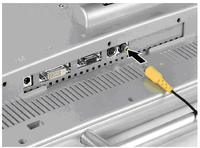 Newer analogue cable boxes offer separate RCA jacks for two-channel stereo output and composite or even s-video outputs to make integration into your home theater system a snap. These audio/video output jacks connect directly to your home theater receiver for video and two-channel audio. You'll need two (2)coaxial/RF cables and a pair of stereo RCA cables with an extra RCA cable for composite video (or an s-video cable if you have those connections available on your receiver and television.)
Newer analogue cable boxes offer separate RCA jacks for two-channel stereo output and composite or even s-video outputs to make integration into your home theater system a snap. These audio/video output jacks connect directly to your home theater receiver for video and two-channel audio. You'll need two (2)coaxial/RF cables and a pair of stereo RCA cables with an extra RCA cable for composite video (or an s-video cable if you have those connections available on your receiver and television.)
CableTV/satellite outlet & coaxial/RF cable
Composite video connector and s-video cable
Step by Step: Connecting a Cable Box (RF Input/Output Only)
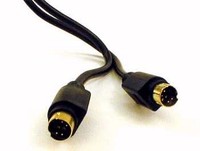 Old fashioned analogue cableTV box use only a coaxial/RF (cable) input and output. This creates a challenge for integration into your home theater system. You must use another piece of equipment such as a stereo TV or VCR to separate audio and video for use with your home theater receiver. You'll need two (2) coaxial/RF cables, a stereo pair of RCA cables, a composite or s-video cable (preferred if s-video is available), and either a stereo TV or VCR.
Old fashioned analogue cableTV box use only a coaxial/RF (cable) input and output. This creates a challenge for integration into your home theater system. You must use another piece of equipment such as a stereo TV or VCR to separate audio and video for use with your home theater receiver. You'll need two (2) coaxial/RF cables, a stereo pair of RCA cables, a composite or s-video cable (preferred if s-video is available), and either a stereo TV or VCR.
- Using one of the coaxial/RF cables, connect the wall jack to the coaxial/RF input of your cableTV box.
- Connect your cableTV box's coaxial/RF output to either the TV or the VCR's coaxial/RF input.
- For Home Theater Receivers (audio): Using the RCA cables connect (the TV or VCR's) left and right audio output to one of the home theater receiver's stereo inputs.
- For Home Theater Receivers (video): If you have a video output, connect the video cable to the receiver's corresponding video input as in the diagram shown (click to enlarge). Then connect the receiver's video output to your television.
![[analogueRCAcables1]](/img/analoguercacables1.jpg) Step by Step: Connect a Digital CableTV Box or Satellite Receiver
Step by Step: Connect a Digital CableTV Box or Satellite Receiver
The next-generation cableTV/satellite boxes added the ability to automatically send audio and video signals to a dedicated home theater receiver. Some even added digital audio ouputs (mostly for satellite boxes). This guide deals with composite and s-video conenctions. If you want to use component video connections, skip down to the Digital HD CableTV/satellite box wiring guide below.
- Using a coaxial/RF cable, connect the wall jack to the coaxial/RF input of your cableTV or satellite box.
- Connect your audio and video (composite or s-video) output jacks directly to available inputs on your home theater receiver.
- For VCR Recording: Connect a pair of RCA analog audio cables and one composite/s-video video cable from an unused output of your receiver to the respective inputs of your VCR.
Digital Cable and Satellite TV with HDTV
Today's digital satellite and cable TV signals are carried on standard coaxial cable. While the physical cable itself looks no different than analogue cable there is considerable difference in the signal's bandwidth. Digital cableTV and satellite TV can carry many more channels with HDTV resolutions and 5.1 Dolby Digital surround.
The back of the Motorola DCT6200 digital cable box
You'll connect digital cableTV and satellite TV in the same way when it comes from the wall. A coaxial/RF cable line is connected from a jack on your wall to a device similar to the Motorola DCT6200 digital cableTV box shown above. This digital cableTV box has all the same features as an equivalent satellite receiver, complete with video outputs for HDTV and S/PDIF digital audio output for 5.1 channel surround. There should be no difference when hooking up a satellite box vs. a cableTV box.
Coaxial/RF
Connections on the digital cable box include the input coaxial/RF jacks like you'll find on a standard analogue cable box. Typically, you can also still send the coaxial/RF output from the box to your VCR for recording programs, though the newest models came with on-board Digital Video Recorders (DVRs). You'll want to check the product manual to ensure that you understand the particular features, quirks, or requirements of your brand/model. The rest of the connectors provide audio and video directly to your home theater receiver.
![[componentsvideocomposite]](/img/componentsvideocomposite.jpg)
![[DigitalCableVCRNEW]](/img/digitalcablevcrnew.gif)
|
Nyrius 5.8GHz 4 Channel Wireless Video & Audio Sender Transmitter & Receiver with IR Remote Extender for Streaming Cable, Satellite, DVD to TV Wirelessly (NY-GS10) Home Theater (Nyrius)
|
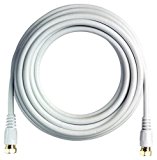
|
BoostWaves BW35W 35' High Definition HDTV White Coaxial Cable, Low Loss Speakers (Uniko Pacific Trading)
|
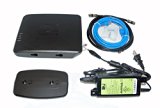
|
DIRECTV CCK-W Wireless Cinema Connection Kit (DCAW1R1-01) Speakers (DIRECTV)
|

|
Logitech Multimedia Speakers Z213 (2.1 Stereo Speakers with Subwoofer) Personal Computer (Logitech)
|
|
FOWOD RG6 TV White Coaxial Cable, 100 Feet, with F-Male Connectors, Double Shielded, High Performance, Indoor and Outdoor Use, for Terrestrial, Cable and Satellite Television, Lifetime Warranty Speakers (ELETA)
|





